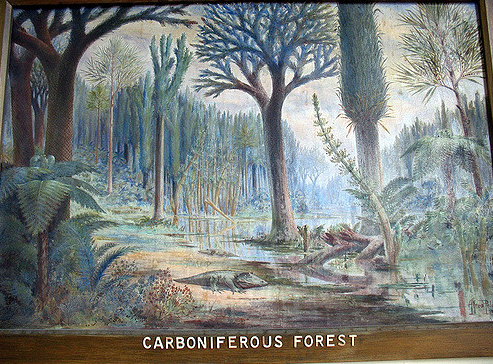The Age of The Insect

This painting at the Rutgers Geology Museum provides an accurate look at the fern forests of the carboniferous.
The world 315 million years ago would have appeared almost alien to a human observer. The dominant land environment during this time period, the carboniferous, was a dark rainforest more vast and dense than any that exists today. The canopies of these forests were equally strange, with massive tree ferns and horsetails the size of bamboo growing up from swampy soil. Early coniferous trees with no leaves or needles but instead long green branches reached even above these. The soil was no doubt crisscrossed by deep, muddy pools like the bayous of modern Louisiana and Florida. With no fruit bearing trees, no useful wooden trunks and branches, and no solid ground the carboniferous would no doubt have been an extremely difficult place to survive on one’s own. And that’s without even mentioning the giant insects.
Yes, the dominant forms of land animal during the carboniferous were giant arthropods. True insects, arachnids, millipedes, crustaceans, all consistently supersized. To be fair, they weren’t quite scaled to monster movie standards, but the apex predators of the carboniferous were certainly close enough. Perhaps the most famous and terrifying were the griffinflies, relative of modern dragonflies that grew to equal hawks in size. The largest of their kind was Meganeura, which had a wingspan reaching several feet. These flying carnivores fed upon equally large herbivorous insects that both flew and crawled. And the crawlers were not alone, for there forest floors were home to other arthropods that equalled and exceeded them in size. Tarantulas the size of the modern birdeaters have been found, as well as two to three foot long scorpions. By far the largest of these monstrous arthropods was the Arthropleura, a huge millipede that grew as long as a car, with knotted body armor quite unlike that of modern millipedes. Despite its terrifying appearance, Arthropleura was a herbivore, the elephant or sauropod (long necked dinosaur) of its day.
These land invertebrates were only one part of a very strange set of animals that lived during the carboniferous. The swamps were also patrolled by giant amphibians the size of crocodiles, and the waterways were home to freshwater sharks and large aquatic arthropods. The up to 20 foot long eurypterids, or sea scorpions, were the largest and most dangerous of these. Relatives of horseshoe crabs, these clawed predators were infact not true scorpions, possessing no stinger but instead a paddled tail. Ironically, the smallest of the carboniferous species were the first amniotes, the first creatures to evolve to lay their eggs on dry land. Though similar to appearance to modern lizards, these unassuming creatures were not true reptiles but would instead diversify in later times into all the mammals and reptiles that would one day grow far larger than any of their carboniferous predators.
The unique creatures of the carboniferous are one of the hardest groups of prehistoric animal to study. Being some of the oldest land animals, their fossils are quite rare and often fragmentary, as many have either been buried under younger rock layers or weathered away long ago. Paleontologists seek to answer questions both about how the insects of the carboniferous grew so large and how their ecosystems may have functioned. Studies of chemical traces left in carboniferous rocks have revealed that the atmosphere of this ancient era was in fact quite different from our own. The total air pressure seems to have been higher, causing stronger winds. The level of moisture is generally greater, which may have been a factor in the large size of the insects. But most significantly, oxygen accounts for 35% of the atmospheric gases, as opposed to the modern 21%. This is a massive increase (one and a half times modern levels) and clearly had profound impacts on life. Most paleontologists agree that it is the primary cause of the gigantic arthropods and amphibians. These species have primitive lungs that struggle to bring oxygen to the extremities of large bodies. With more oxygen in the atmosphere, these systems would have been supplemented and allowed for larger bodies.
As for the ecosystems of the carboniferous, there is very little evidence for how these animals interacted aside from what they ate. It seems that griffinflies and arachnids such as spiders and scorpions may have been the largest land predators, competing with the amphibians to consume browsing insects. Analyzing modern insect ecosystems in the tropical rainforests may provide some insight into their behavior. Unlike many vertebrates, most insects are solitary and only colonial species are particularly interested in what others of their own kind do. The carboniferous ecosystems may have been devoid of the interesting social interactions that fascinate modern ecologists.
The carboniferous lasted from 358 to 298 million years ago, beginning with a noticeable increase in the size of trees and ending with the elimination much of the global covering of rainforest. The climate seems to have shifted fairly suddenly from hot and humid to cool and arid, possibly caused by an ice age. Whatever happened removed much of the moisture and oxygen from the atmosphere, bringing an end to the age of the giant insects and allowing amniotes, us, to take over the world’s ecosystems.










